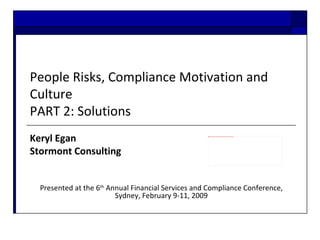People Risks, Compliance Motivation and Culture Part 2 Ve 20090818
•Télécharger en tant que PPT, PDF•
1 j'aime•911 vues
Part 2 uses the hypothetical Blue Sky Bank to illustrate how Influencer methodology provides a framework for cultural change to achieve improved compliance motivation and corporate social responsibility.
Signaler
Partager
Signaler
Partager

Recommandé
Recommandé
Every company would love for its employees to demonstrate accountability; to take ownership of their work. However, despite their best efforts, few companies understand what it takes to create and sustain a culture of accountability. This presentation will presents the basic components of a methodology for creating workplace accountability.Workplace Accountability: How Effective Managers Create a Culture of Ownership

Workplace Accountability: How Effective Managers Create a Culture of OwnershipThe Business LockerRoom
Contenu connexe
Tendances
Every company would love for its employees to demonstrate accountability; to take ownership of their work. However, despite their best efforts, few companies understand what it takes to create and sustain a culture of accountability. This presentation will presents the basic components of a methodology for creating workplace accountability.Workplace Accountability: How Effective Managers Create a Culture of Ownership

Workplace Accountability: How Effective Managers Create a Culture of OwnershipThe Business LockerRoom
Tendances (20)
Building a Culture of Ownership on a Foundation of Values

Building a Culture of Ownership on a Foundation of Values
Culture First: Day 3, Scaling Leadership Development in a Distributed World

Culture First: Day 3, Scaling Leadership Development in a Distributed World
Creating a culture of accountability breakout workshop presentation

Creating a culture of accountability breakout workshop presentation
Reimagining Feedback for the 21st Century Workplace

Reimagining Feedback for the 21st Century Workplace
Workplace Accountability: How Effective Managers Create a Culture of Ownership

Workplace Accountability: How Effective Managers Create a Culture of Ownership
Similaire à People Risks, Compliance Motivation and Culture Part 2 Ve 20090818
Similaire à People Risks, Compliance Motivation and Culture Part 2 Ve 20090818 (20)
The work of HR part two the flow ofinformation and work.docx

The work of HR part two the flow ofinformation and work.docx
Rahul Pulimamidi Week 3 Question 1Top of FormExecutiv.docx

Rahul Pulimamidi Week 3 Question 1Top of FormExecutiv.docx
Improving Employee Performance by Mirza Yawar Baig

Improving Employee Performance by Mirza Yawar Baig
Getting your shift together making sense of organizational culture and change

Getting your shift together making sense of organizational culture and change
2015 Creating a Psychologically Informed Environment

2015 Creating a Psychologically Informed Environment
People Risks, Compliance Motivation and Culture Part 2 Ve 20090818
- 1. People Risks, Compliance Motivation and Culture PART 2: Solutions Keryl Egan Stormont Consulting Presented at the 6 th Annual Financial Services and Compliance Conference, Sydney, February 9-11, 2009
- 3. Navigating Change with Influencer Influencer The Power to Change Anything
- 5. Setting the Sails for Change with Influencer
- 18. Six Sources of Influence for 3 Vital Behaviours Speaking Up, Admitting Mistakes, Volunteering Ideas Use office design, data and cues plus IT tools to keep the vital behaviours in mind Design incentives and rewards for speaking up, admitting mistakes and innovating Structural Seek support of senior management who are willing to provide resources or knowledge and problem-solving Find role models and opinion leaders to help others to speak up, admit mistakes and volunteer ideas Social Provide training to enable the vital behaviours e.g. Crucial Conversations training for speaking up in high stakes situations Connect the person to their own values. Create a crisis of conscience by expecting people to speak up. Personal Ability Motivation
- 22. P.O. Box 327, Leichhardt NSW 2040 Ph: 02 9564 0425 Mobile: 0414 734 840 Email: [email_address] Website: www.stormontconsulting.com Thank you
Notes de l'éditeur
- A model which can literally be applied to all types of change.
- Use these principles to help you determine the vital behaviours you want to change to gain compliance and valuing of regulation. Nick Leeson from Barings wanted recognition.
- Choose two of these – speaking up and admitting to mistakes
- An example of a crucial moment may be the immediate moment that a breach is observed.
